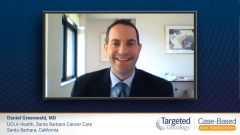
Tailored Treatment Approaches for Newly Diagnosed Follicular Lymphoma
Treatment advice for community oncologists and hematologists who treat follicular lymphoma based on therapeutic advances occurring rapidly in the field.
Episodes in this series

Daniel Greenwald, MD: I always explain to patients that compared to my father’s generation of oncology, and even when I was in medical school, we understand so much more about the immune system and the molecular pathogenesis of cancer in general, but certainly lymphoma. That has resulted in a finer and finer categorization of lymphomas into various subsets. There’s no question that over the next 10 years and 20 years, we will redefine lymphomas into even finer categories that help to tailor our understanding of prognosis, but also therapy. There’s no doubt that the molecular profiling will probably alter our decisions in the future. At the immediate time, it’s not really impacting lymphoma or follicular lymphoma as much as other types of non-Hodgkin’s lymphoma, such as CLL [chronic lymphocytic leukemia]. There are a lot of interesting areas that are rich for potential targets for therapy. Enhancing our ability to use the immune system is going to be key as time goes on and it’ll extend beyond just anti-CD20 antibody therapy to novel forms of antibody-drug conjugates, novel forms of antibodies that lock onto or attack other targets and lymphomas and as I mentioned earlier, cellular therapy that uses either self-made T cells or engineered off-the-shelf T cells. Also, there’s interest in using what are called BiTEs, or bispecific antibodies, that can draw components of one’s immune system more directly into the lymphoma population to treat it. Beyond those immunotherapy approaches, there is still quite a bit of interest in using targeted therapies. We have several of these in use for various forms of non-Hodgkin’s lymphoma that target various pathways and it may be that combining them, although, potentially very costly in terms of the coverage, may be effective in overcoming some of the deficiencies or limitations of single drug approaches.
The key takeaway or clinical pearls I would offer is that follicular lymphoma is a very heterogeneous disease that fortunately for most patients carries a very long survival, and that’s the thing that needs to be emphasized to patients. Obviously, most clinicians understand that historically we view follicular lymphoma as an incurable subtype of lymphoma, but one that can be usually, or often successfully, managed over years to even decades. It’s important that if one requires treatment, that the best attempt at remission be achieved upfront, but understanding the risks of toxicity and taking that into consideration when tailoring a treatment plan for a patient. It’s important to consider options very carefully as some forms of cytotoxic chemotherapy, as well as immunotherapy, can have both short-term and long-term toxicities. But understand that there is support from colleagues in academic medicine who are willing to see patients on a consultative basis, help in a collaborative fashion design a treatment plan, and that can often be implemented in the community. It’s important as a treating clinician to reassure patients that this is an area that is rapidly evolving, rapidly improving, and that survival is often measured in years to decades.
Transcript edited for clarity.
Case: A 45-Year-Old Woman with Follicular Lymphoma
Initial presentation
- A 45-year-old woman presents with a 2-month history of fatigue and abdominal pain, enlarged lymph nodes in her right neck, and a 5-lb unintentional weight loss
- PMH: Unremarkable
- PE: right cervical and axillary lymph nodes palpated ~2 cm; spleen palpable 3 cm below left costal margin
Clinical workup
- Labs: ANC 1.5 x 10^9, WBC 11.7 x 10^9, lymphocytes 41%, Hb 8.7 g/dL, plt 101 x10^9, LDH 305U/L, 3.6 B2M ug/mL; HBV negative
- Excisional biopsy of cervical lymph node on IHC showed CD20+, CD10+, BCL2+, follicular lymphoma grade 2
- Bone marrow biopsy showed paratrabecular lymphoid aggregates, 43% involvement
- Cytogenetics: t(14:18) (q32;q21)
- PET/CT showed right axillary, cervical, and mediastinal lymphadenopathy (2.7 cm, 2.5 cm, and 2.6 cm respectively)
- Ann Arbor Stage IV, ECOG PS is 1
Treatment
- Patient was treated with obinutuzumab plus bendamustine chemotherapy. She completed 6 cycles and treatment was well tolerated.
- She continued on obinutuzumab maintenance.
- 30 months later, she complains of fevers, chills, and decreased appetite.






































